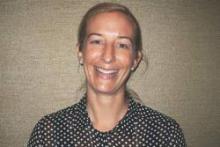SEATTLE – A new study using an analytic framework grounded in behavior change theory shows several modifiable ways to help patients with knee and/or hip osteoarthritis to exercise, the most influential being beliefs about exercise, medical advice, gym referral, supervision, and encouragement, according to a report at the World Congress on Osteoarthritis.
“Our study provides a comprehensive synthesis of the many barriers and facilitators faced by those with osteoarthritis regarding intentional exercise,” commented lead investigator Philippa Nicolson, a research scientist at the Centre for Health, Exercise & Sports Medicine, University of Melbourne.
“Importantly, exercise adherence is not a problem that patients can solve on their own. Clinicians must take an active and leading role in identifying and considering barriers and facilitators to exercise, and engage with patients to create a patient-centered exercise plan that suits each individual’s needs and circumstances,” she recommended. “Clinicians must also help patients to gain the knowledge and skills that they need in order to adhere to exercise in the long term.”
In an interview, Stephen P. Messier, Ph.D., session comoderator and professor and director of both the J.B. Snow Biomechanics Laboratory and the Wake Forest University Runners’ Clinic in Winston-Salem, N. C., said, “A lot of this is not new information, I would say, but it really is important that [clinicians] understand that people who have been sedentary all their lives need help. They can’t do it on their own.”
Critical issues are how to stay in contact with patients and give them ongoing support in the long term, he noted, adding that, with social media and other methods, physicians can give patients personal help in the beginning and then wean them off of that help but still stay in contact in some way so patients feel like they have someone to talk to and someone that cares.
The physician plays a key role in the process, all the way from prescribing exercise to identifying suitable facilities to monitoring progress. “When your doctor cares about it, then older folks are going to do it because they really pay attention to what the physician says,” Dr. Messier said.
Introducing the study, Ms. Nicolson commented, “Exercise is a core component of osteoarthritis management and is now recommended in all clinical guidelines. High-quality evidence for the benefits of exercise in improving pain and function for those with lower-limb osteoarthritis are well established. However, exercise is globally underutilized, and among those for whom exercise is prescribed, adherence is found to be poor, particularly in the long term.”
“Understanding the barriers and facilitators to exercise will allow clinicians to change their practice to better facilitate adherence and allow researchers to develop and evaluate behavioral interventions targeting improved adherence,” she explained. “Given that initiating and adhering to exercise often requires significant behavior change, the use of behavior change theory is essential. In order to facilitate people with osteoarthritis to exercise, we need to analyze the behaviors influencing exercise participation. Interventions based on behavior change theory have been found to be significantly more successful than those that are not.”
The investigators conducted a scoping review to identify exercise barriers and facilitators in this population. They identified 23 relevant articles on intentional exercise (supervised or not and prescribed or self-initiated) among a total of 4,633 patients aged 45 years or older with hip and/or knee osteoarthritis.
Most of the more than 200 barriers and facilitators extracted from the articles were modifiable, according to data reported at the meeting, which was sponsored by the Osteoarthritis Research Society International.
The investigators mapped these modifiable factors onto domains of the Theoretical Domains Framework, which integrates multiple behavior change theories into a single framework and is aimed at helping researchers identify processes that do and do not work (Implement. Sci. 2012;7:37). They found that the barriers and facilitators mapped onto all 14 domains.
Among highlights, the many barriers mapping onto the framework’s Environmental Context and Resources domain included having to descend hills or stairs during a walking program, inability to find a suitable exercise, and rigidity of the program. Facilitators mapping onto this domain included use of a pedometer, physical therapist guidance, and receipt of a gym referral from the doctor.
Barriers mapping onto the Beliefs About Consequences domain included a belief that exercise has limited benefit, fear about damaging the joint further, and concern about precipitating pain.
Facilitators mapping onto the Reinforcement domain included medical advice to exercise, telephone reinforcement, and getting physician encouragement.
“Our findings have a number of clinical implications,” commented Ms. Nicolson.



